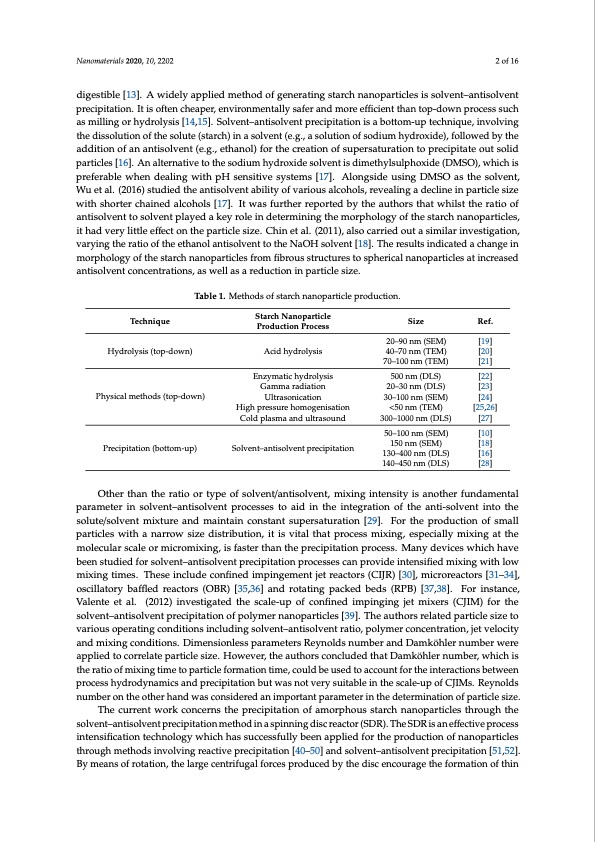
PDF Publication Title:
Text from PDF Page: 002
Nanomaterials 2020, 10, 2202 2 of 16 digestible [13]. A widely applied method of generating starch nanoparticles is solvent–antisolvent precipitation. It is often cheaper, environmentally safer and more efficient than top-down process such as milling or hydrolysis [14,15]. Solvent–antisolvent precipitation is a bottom-up technique, involving the dissolution of the solute (starch) in a solvent (e.g., a solution of sodium hydroxide), followed by the addition of an antisolvent (e.g., ethanol) for the creation of supersaturation to precipitate out solid particles [16]. An alternative to the sodium hydroxide solvent is dimethylsulphoxide (DMSO), which is preferable when dealing with pH sensitive systems [17]. Alongside using DMSO as the solvent, Wu et al. (2016) studied the antisolvent ability of various alcohols, revealing a decline in particle size with shorter chained alcohols [17]. It was further reported by the authors that whilst the ratio of antisolvent to solvent played a key role in determining the morphology of the starch nanoparticles, it had very little effect on the particle size. Chin et al. (2011), also carried out a similar investigation, varying the ratio of the ethanol antisolvent to the NaOH solvent [18]. The results indicated a change in morphology of the starch nanoparticles from fibrous structures to spherical nanoparticles at increased antisolvent concentrations, as well as a reduction in particle size. Table 1. Methods of starch nanoparticle production. Starch Nanoparticle Production Process Acid hydrolysis Enzymatic hydrolysis Gamma radiation Ultrasonication High pressure homogenisation Cold plasma and ultrasound Solvent–antisolvent precipitation Size Ref. Technique Hydrolysis (top-down) Physical methods (top-down) Precipitation (bottom-up) 20–90 nm (SEM) [19] 40–70 nm (TEM) [20] 70–100 nm (TEM) [21] 500 nm (DLS) [22] 20–30 nm (DLS) [23] 30–100 nm (SEM) [24] <50 nm (TEM) 300–1000 nm (DLS) [27] 50–100 nm (SEM) [10] 150 nm (SEM) [18] 130–400 nm (DLS) [16] 140–450 nm (DLS) [28] [25,26] Other than the ratio or type of solvent/antisolvent, mixing intensity is another fundamental parameter in solvent–antisolvent processes to aid in the integration of the anti-solvent into the solute/solvent mixture and maintain constant supersaturation [29]. For the production of small particles with a narrow size distribution, it is vital that process mixing, especially mixing at the molecular scale or micromixing, is faster than the precipitation process. Many devices which have been studied for solvent–antisolvent precipitation processes can provide intensified mixing with low mixing times. These include confined impingement jet reactors (CIJR) [30], microreactors [31–34], oscillatory baffled reactors (OBR) [35,36] and rotating packed beds (RPB) [37,38]. For instance, Valente et al. (2012) investigated the scale-up of confined impinging jet mixers (CJIM) for the solvent–antisolvent precipitation of polymer nanoparticles [39]. The authors related particle size to various operating conditions including solvent–antisolvent ratio, polymer concentration, jet velocity and mixing conditions. Dimensionless parameters Reynolds number and Damköhler number were applied to correlate particle size. However, the authors concluded that Damköhler number, which is the ratio of mixing time to particle formation time, could be used to account for the interactions between process hydrodynamics and precipitation but was not very suitable in the scale-up of CJIMs. Reynolds number on the other hand was considered an important parameter in the determination of particle size. The current work concerns the precipitation of amorphous starch nanoparticles through the solvent–antisolvent precipitation method in a spinning disc reactor (SDR). The SDR is an effective process intensification technology which has successfully been applied for the production of nanoparticles through methods involving reactive precipitation [40–50] and solvent–antisolvent precipitation [51,52]. By means of rotation, the large centrifugal forces produced by the disc encourage the formation of thinPDF Image | Hydro Starch Nanoparticles Precip Spinning Disc Reactor

PDF Search Title:
Hydro Starch Nanoparticles Precip Spinning Disc ReactorOriginal File Name Searched:
nanomaterials-10-02202-v2.pdfDIY PDF Search: Google It | Yahoo | Bing
Turbine and System Plans CAD CAM: Special for this month, any plans are $10,000 for complete Cad/Cam blueprints. License is for one build. Try before you buy a production license. More Info
Waste Heat Power Technology: Organic Rankine Cycle uses waste heat to make electricity, shaft horsepower and cooling. More Info
All Turbine and System Products: Infinity Turbine ORD systems, turbine generator sets, build plans and more to use your waste heat from 30C to 100C. More Info
CO2 Phase Change Demonstrator: CO2 goes supercritical at 30 C. This is a experimental platform which you can use to demonstrate phase change with low heat. Includes integration area for small CO2 turbine, static generator, and more. This can also be used for a GTL Gas to Liquids experimental platform. More Info
Introducing the Infinity Turbine Products Infinity Turbine develops and builds systems for making power from waste heat. It also is working on innovative strategies for storing, making, and deploying energy. More Info
Need Strategy? Use our Consulting and analyst services Infinity Turbine LLC is pleased to announce its consulting and analyst services. We have worked in the renewable energy industry as a researcher, developing sales and markets, along with may inventions and innovations. More Info
Made in USA with Global Energy Millennial Web Engine These pages were made with the Global Energy Web PDF Engine using Filemaker (Claris) software.
Infinity Turbine Developing Spinning Disc Reactor SDR or Spinning Disc Reactors reduce processing time for liquid production of Silver Nanoparticles.
| CONTACT TEL: 608-238-6001 Email: greg@infinityturbine.com | RSS | AMP |